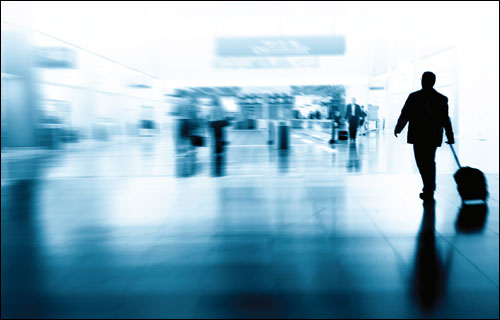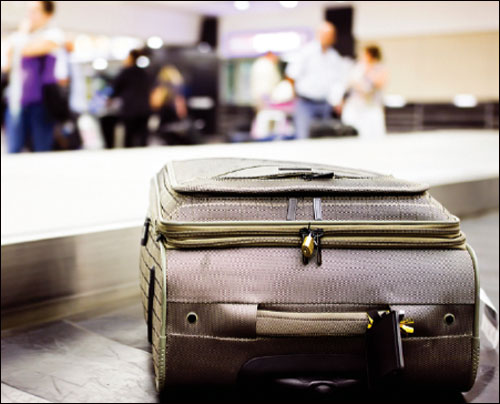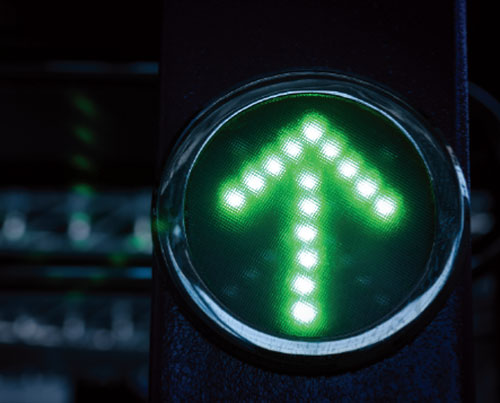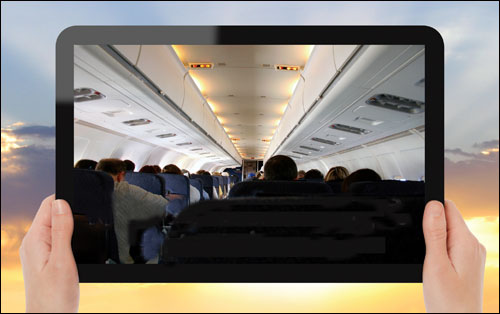Back in 2003, McCarran International Airport, in Las Vegas, placed a bet on radio frequency technology: It would bring baggage handling under its own operations, rather than have the airlines continue to manage the bags checked into their flights. And it would replace a bar-code system for tracking and sorting baggage with RFID, to improve speed and accuracy. McCarran is a major origin and destination for travelers, making it one of the highest-volume baggage-handling operations in the United States. On an average day, roughly 30,000 bags are checked in here, and that number can swell to 70,000 on days when a large conference ends, says Samuel Ingalls, McCarran’s assistant director of aviation information systems.
Today, that bet has paid off. McCarran equipped airlines with RFID printer-encoders to generate RFID labels. Tagged bags move on conveyor systems outfitted with RFID readers through multiple buildings, as they are screened and then sent to the designated airlines. The airport accurately reads the RFID tags attached to “north of 99 percent—sometimes north of 99.5 percent” of the bags it receives, Ingalls says. The industry-standard read rate for bar-code labels generally averages around 85 percent. (Bar-code scanners often accumulate dirt, degrading the laser arrays, or the labels get folded so the bar codes can’t be read.) Accurately tracked bags are less likely to be lost or misplaced, which translates into fewer liabilities for the airport. And, of course, it means a smoother travel experience for passengers.
|
|
But unlike McCarran, most U.S. airports do not manage baggage, and most airlines have not invested in RFID-based baggage-tracking systems. In Asia and Europe, where airports are more likely to manage luggage, Hong Kong International Airport, Portugal’s Lisbon Airport and Denmark’s Aalborg Airport are among the air-transport facilities that have RFID tracking systems in place. Several airlines have tested RFID for baggage handling, but only a handful, including Air France-KLM and Asiana Airlines, have adopted the technology.
In 2007, mishandled baggage cost the air-transport industry $3.8 billion, according to SITA, an IT and communications services provider to the air-transport industry. In recent years, there has been a 40 percent decline in mishandling rates, which SITA attributes to software improvements in bar-code systems, and fewer checked bags—due to the recession, which resulted in fewer passengers, and the introduction of baggage fees at most airlines. But as the economy recovers and travel increases, airlines may see the number of mishandled bags and the associated costs climb again.
For now, adoption of RFID baggage-handling systems lingers, as airports and airlines try to figure out how to move forward. Meanwhile, some airports are finding value in RFID-tracking assets, such as dollies, hazardous cargo and vehicles. Other airports are developing RFID applications to improve customer services on the ground. And one budget airline has adopted RFID to keep passengers happy in the air.
Chicken or Egg Conundrum
Technology trials and real-world rollouts have proved that RFID-based baggage-handling systems work. Lisbon Airport, for example, reports that its system reduces the average time to process a transfer bag by at least 66 percent, and faster, more accurate baggage turnaround equates directly to savings. McCarran was so satisfied with its system that, in 2006, the airport began using RFID to track bags checked in on the Las Vegas strip. And Hong Kong Airport says its RFID system has improved handling capacity by approximately 5 percent; it tracks some 40,000 bags daily.
In addition, the International Air Transport Association (IATA) has developed data and technology standards for RFID tags, based on ISO 18000-6C inlays. This has paved the way for RFID data sharing between airports and airlines, just as bar-code data is shared today. But RFID tags can store more data, which will mean tighter alignment between passenger and flight data.
While the business benefits are clear, the cost structure is not. McCarran, for example, paid for the entire RFID system, because it has centralized baggage handling. But who foots the bill when each airline handles its own baggage, from the point of check-in all the way to the plane?
In some cases, airports are willing to pay for the RFID reader infrastructure if airlines pay for tags. But most airlines aren’t ready to take that step. The economic state is the obvious reason for not investing in RFID technology. But Nick Gates, portfolio director for baggage at SITA, thinks it’s more than that. “Airlines are skeptical,” he says. “You have to make certain assumptions about the value you’ll get, and if you make a mistake, you might get it wrong.”
There’s another problem. “To really get the most benefit from the use of RFID, you need to have it installed across a network of airports,” says Chris Goater, communications manager for IATA. “So even airlines that make successful business cases are very cautious to adopt RFID, and with good reason.”
The situation is frustrating to many in the air-transport industry. “We have been doing successful trials and tests to try and harness the technology [for baggage tracking] over the past few years,” says Mark van Gaalen, strategic adviser of baggage logistics and innovation for Amsterdam Airport Schiphol. “As things are now, Amsterdam Airport Schiphol is ready to implement RFID-based baggage handling. The airlines visiting our airport, however, are not. A short survey showed no active interest in RFID with the airlines for the short and mid term. We have, therefore, frozen our plans to invest in RFID technology until one or more airlines request baggage handling using RFID.”
The air-transport industry needs to “change the philosophy in this space,” says Michael J. Liard, RFID practice director at ABI Research, a technology research firm. “Think of baggage as items, just as apparel or pharmaceuticals are viewed in their respective supply chains, because baggage handling is a supply chain.” He believes this would help frame the process as a shared responsibility, and that improved handling will benefit all parties, through lower costs and improved customer service.
Asset Tracking Takes Off
In aviation, as in health care, manufacturing and other sectors, asset-tracking solutions often mature faster than supply-chain applications. Lufthansa, for example, is adopting and testing RFID to improve a myriad of operations. Lufthansa Technik (LHT), the airline’s maintenance repair and overhaul arm, is using passive ultrahigh-frequency tags to track the paperwork attached to aircraft parts, to boost the efficiency of its parts maintenance and repair process, and keep better track of parts as they are transported between warehouses and repair facilities in Germany. LHT also is using passive high-frequency tags to track airplane seats between aircraft and warehouses, to speed up the process of exchanging business- and economy-class seats, based on ticket sales. This has reduced the amount of time it takes to locate and replace 10 seats from 30 minutes to five minutes.
LHT is now testing RFID for tracking life vests, first-aid kits and other safety items used on aircraft, to manage inventory levels and expirations dates. And Lufthansa’s Cargo division is testing RFID to identify hazardous or volatile materials, and ensure they are not stacked next to each other.
Asia Airfreight Terminal deployed an RFID-based truck-control system to monitor and manage traffic flow at two air-cargo terminals it operates at Hong Kong International Airport. This reduced congestion and resulted in a labor savings of roughly $8.5 million per year.
Munich Airport is employing RFID to track freight dollies, and to integrate the information into its airport process-management software. The RFID system enables managers to locate dollies instantly, so it knows which are available for use.
Emirates SkyCargo, a division of Emirates Airlines, has completed a number of technology trials that demonstrate RFID’s ability to deliver significant business value for tracking unit load devices and large storage pallets used to transport cargo, according to Vasih Khan, a cargo systems analyst at Emirates Airlines.
Heathrow Airport, in London, and other airports are investing in RFID to track and manage underground utilities. RFID can save time and labor costs, compared with locating utilities through conventional cable-tracing techniques.
The U.S. Federal Aviation Administration (FAA) has buried more than 1,000 RFID-enabled marker balls around a new runway at the Hartsfield-Jackson Atlanta International Airport, to locate and better manage buried utility cables and pipes. “Airports, especially major ones, are very dynamic environments, with constant improvements and construction—terminal expansion, new taxiways, runway extensions, etc.—going on,” says FAA project engineer Brian Murphy. For the FAA, accurately knowing the location of underground cables on the airfield is vital. “Cable cuts can cause disruption and costly delays with airport operations,” Murphy says. The marker balls are intended to help prevent cable cuts.
RFID on Border Patrol
To improve security, more than 30 countries—including Australia, Belgium, France, Germany, Ireland, Japan, New Zealand, Portugal, Russia, Singapore, Sweden, the United Kingdom and the United States—have integrated RFID tags into government-issued passports. Now, international airports in several countries—including Finland, Portugal, the U.K. and Venezuela—are leveraging these electronic passports to expedite the customs process for citizens of those respective countries.
Travelers with e-passports can skip long lines at customs by using automated self-service gates, from Lisbon-based Vision-Box. The system is easy to use. At the gate entrance, you place your e-passport on a reader platform that collects the data stored in the embedded RFID inlay (the passports carry ISO 14443 standard inlays). You’re then allowed into a secured partition, where a camera captures a facial image. If the government collected your fingerprint or other biometric data before issuing your e-passport, that is also scanned. Software then compares the biometric data collected onsite with the biometric data linked to the e-passport record. If it deems the two sets a match, the gate opens and you’re allowed to proceed.
Vision-Box says it takes travelers less than 20 seconds to clear customs with its system. This summer, the e-gates will be deployed at Amsterdam Airport Schiphol, and they are currently being tested at Brasília International Airport, in Brazil. “IATA is closely working with governments that are processing passengers through automated border-entry programs,” Goater says. “The aim is to facilitate the increasing numbers of travelers within the existing floor space without compromising border protection.”
Hassle-Free Travel?
Some airlines are investing in RFID to improve customer services, by reducing waiting times. Many of these services are geared toward tech-savvy travelers, who are never without their mobile phones.
Air New Zealand, for example, invites frequent fliers to visit an RFID-enabled kiosk at any of the country’s 26 airports, to obtain an ePass, similar in size to a bar-code sticker, that can be attached to their mobiles phone. The reusable RFID-enabled ePass lets travelers check their baggage at kiosks, access passenger lounges and board planes without paper documents.
Other airlines are testing and piloting programs that rely on mobile phones equipped with Near-Field Communication (NFC), a short-range, high-frequency wireless technology that enables data exchange between two devices over a distance of a few centimeters. Nokia and Samsung are among the manufacturers integrating NFC technology into their mobile phones. Research In Motion, which makes the BlackBerry, says it’s adding NFC technology to new handsets, and many analysts predict the Apple iPhone 5, which may come out later this year, will include NFC. Apple has applied for a patent covering the use of NFC technology in the iPhone to buy airline tickets and check in baggage.
“We’re projecting 35 million NFC handsets will enter the market this year,” says John Devlin, senior practice director at ABI Research. “But that doesn’t include the iPhone 5. If it comes out with NFC, we expect that number to double.” From there, growth is anticipated to skyrocket—with the number of NFC-enabled handsets doubling in 2012.
During a pilot program conducted from 2009 to 2010 at France’s Nice Côte d’Azur Airport, NFC phones were provided to 50 frequent fliers, who used them to check in for Air France flights. The details typically printed on a boarding card were stored electronically to an application running on the phone, which was read, just like an RFID tag, at the security and boarding gates. “We believe NFC is likely to play a significant role in the future of mobile boarding passes,” says Debbie Iannaci, director of public relations for Amadeus, the systems integrator on the Air France NFC pilot.
Japan Airlines, All Nippon Airways and Scandinavian Airlines are also testing various NFC applications. IATA has identified NFC as a growth area for the air-transport industry and has formed a working group, led by Air Canada and including representatives from mobile phone association GSM, to develop NFC use cases and implementation guidelines.
Of course, NFC check-in and related airport services will also require airlines and airports to invest in the required technology. But the air-transport industry may soon have more resources to do just that, as well as to invest in infrastructures to support RFID baggage-tracking systems. In 2010, IT budgets grew for most airports and for 44 percent of airlines, according to a recent SITA report. Spending is forecast to increase throughout this year, with baggage processing listed as a priority for 33 percent of airports and 41 percent of airlines.
“As a consumer,” Liard says, “I look at the baggage fees I need to pay now and I ask, ‘What am I getting in exchange for my fee?’ If airlines could put that money toward investing in an RFID infrastructure, then RFID could take the role of improving baggage handling and providing better customer service.”
RFID Secures In-Flight Entertainment
While many airlines are increasing fares and cutting customer services to compensate for rising fuel costs, Jetstar, which serves Asia, Australia and New Zealand, is betting it can stay profitable by offering inexpensive seats and an enjoyable travel experience. To that end, the budget airline is introducing an in-flight entertainment system—an iPad preloaded with movies, TV shows, music, e-books, news and games. It’s offered free to first-class travelers and available for a small fee to economy-class passengers.
Jetstar had two requirements, says David Brown, joint managing director of Bluebox Avionics, a provider of in-flight entertainment, which developed the iPad system. The device had to have at least 20 hours of battery life, so it could be used on both legs of the airline’s longest flights—roughly nine hours each way—without a recharge, he says. And a security system was essential to ensure the much-loved mobile devices didn’t disembark with passengers.
The solution to the first requirement—extending the iPad’s 10-hour battery life with an external battery—created an opportunity to use RFID to track the mobile devices. “We didn’t want to open up the iPad and add an RFID tag,” Brown says. “But we could easily add a tag inside the case that housed the second battery.” The cover has a small, flexible arm that a passenger can pop out to prop the iPad up on the seat tray, for easier viewing.
When a passenger powers up the iPad, an on-screen notice explains that the iPad will be collected at the end of the flight, and that it contains an RFID tag to prevent theft. As the crew prepares for landing, flight attendants ask passengers to power down the iPads, and once the aircraft has landed and is making its way to the gate, attendants collect the devices. If they get back fewer than they distributed, a crew member announces that there are still some outstanding iPads, and a flight attendant walks down the aisle again—but this time, with a handheld RFID reader that issues an alert when it detects one of the tagged iPads.
It’s too early to tell how successful the program will be, but Brown says that during the technology trials, the RFID system—which employs passive ultrahigh-frequency tags provided by CoreRFID and handheld readers from ATiD—worked perfectly. “They’d hide the iPads in various places, like the seat-back pocket, in the overhead bins, slipped between and under the seats, and then they’d do a sweep of the planes,” he says. “The tags were read without fail.”
Photos: iStockphoto





